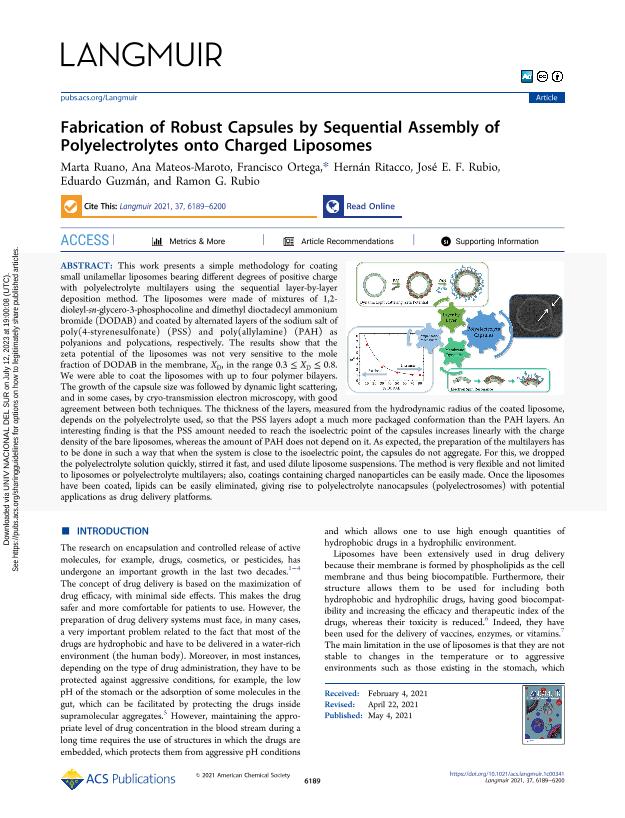Artículo
Fabrication of Robust Capsules by Sequential Assembly of Polyelectrolytes onto Charged Liposomes
Ruano, Marta; Mateos Maroto, Ana; Ortega, Francisco; Ritacco, Hernán Alejandro ; Fernández Rubio, José Emilio; Guzmán, Eduardo; Rubio, Ramón G.
; Fernández Rubio, José Emilio; Guzmán, Eduardo; Rubio, Ramón G.
 ; Fernández Rubio, José Emilio; Guzmán, Eduardo; Rubio, Ramón G.
; Fernández Rubio, José Emilio; Guzmán, Eduardo; Rubio, Ramón G.
Fecha de publicación:
04/05/2021
Editorial:
American Chemical Society
Revista:
Langmuir
ISSN:
0743-7463
Idioma:
Inglés
Tipo de recurso:
Artículo publicado
Clasificación temática:
Resumen
This work presents a simple methodology for coating small unilamellar liposomes bearing different degrees of positive charge with polyelectrolyte multilayers using the sequential layer-by-layer deposition method. The liposomes were made of mixtures of 1,2-dioleyl-sn-glycero-3-phosphocoline and dimethyl dioctadecyl ammonium bromide (DODAB) and coated by alternated layers of the sodium salt of poly(4-styrenesulfonate) (PSS) and poly(allylamine) (PAH) as polyanions and polycations, respectively. The results show that the zeta potential of the liposomes was not very sensitive to the mole fraction of DODAB in the membrane, XD, in the range 0.3 ≤ XD ≤ 0.8. We were able to coat the liposomes with up to four polymer bilayers. The growth of the capsule size was followed by dynamic light scattering, and in some cases, by cryo-transmission electron microscopy, with good agreement between both techniques. The thickness of the layers, measured from the hydrodynamic radius of the coated liposome, depends on the polyelectrolyte used, so that the PSS layers adopt a much more packaged conformation than the PAH layers. An interesting finding is that the PSS amount needed to reach the isoelectric point of the capsules increases linearly with the charge density of the bare liposomes, whereas the amount of PAH does not depend on it. As expected, the preparation of the multilayers has to be done in such a way that when the system is close to the isoelectric point, the capsules do not aggregate. For this, we dropped the polyelectrolyte solution quickly, stirred it fast, and used dilute liposome suspensions. The method is very flexible and not limited to liposomes or polyelectrolyte multilayers; also, coatings containing charged nanoparticles can be easily made. Once the liposomes have been coated, lipids can be easily eliminated, giving rise to polyelectrolyte nanocapsules (polyelectrosomes) with potential applications as drug delivery platforms.
Palabras clave:
LIPOSOMES
,
LAYER BY LAYER
,
CAPSULES
,
NANOTECHNOLOGY
Archivos asociados
Licencia
Identificadores
Colecciones
Articulos(IFISUR)
Articulos de INSTITUTO DE FISICA DEL SUR
Articulos de INSTITUTO DE FISICA DEL SUR
Citación
Ruano, Marta; Mateos Maroto, Ana; Ortega, Francisco; Ritacco, Hernán Alejandro; Fernández Rubio, José Emilio; et al.; Fabrication of Robust Capsules by Sequential Assembly of Polyelectrolytes onto Charged Liposomes; American Chemical Society; Langmuir; 37; 20; 4-5-2021; 6189-6200
Compartir
Altmétricas



